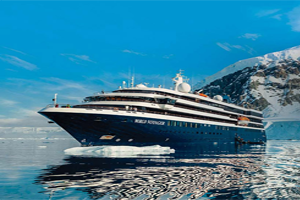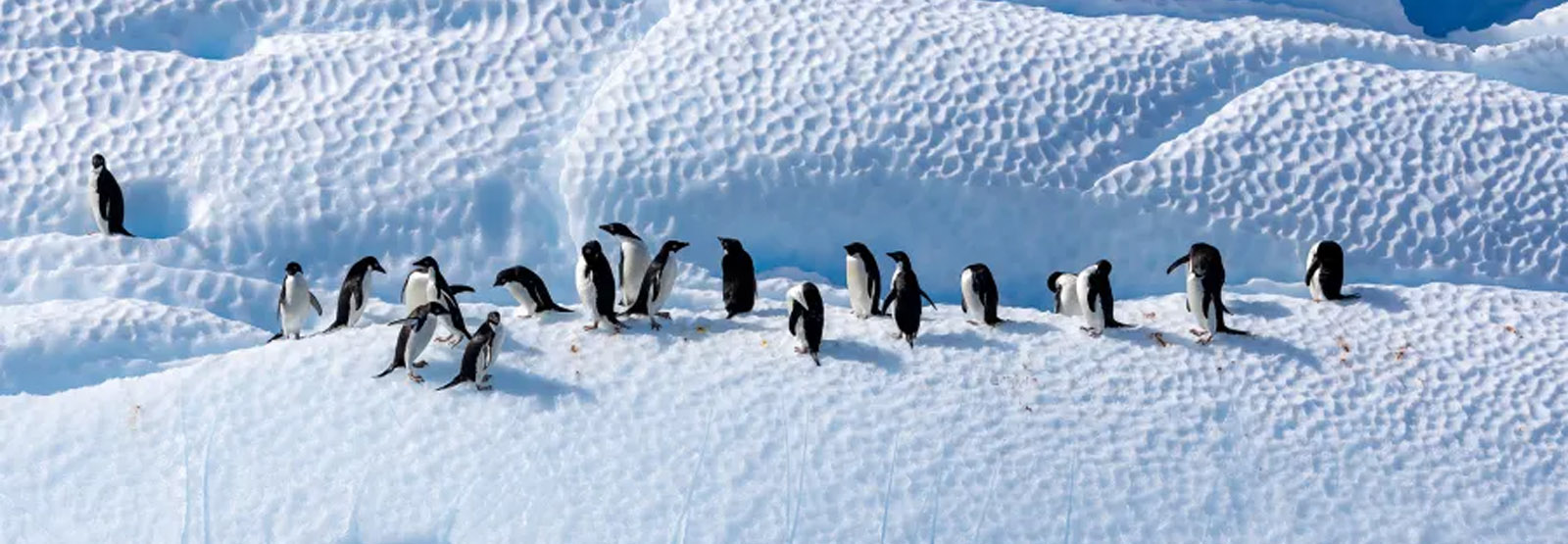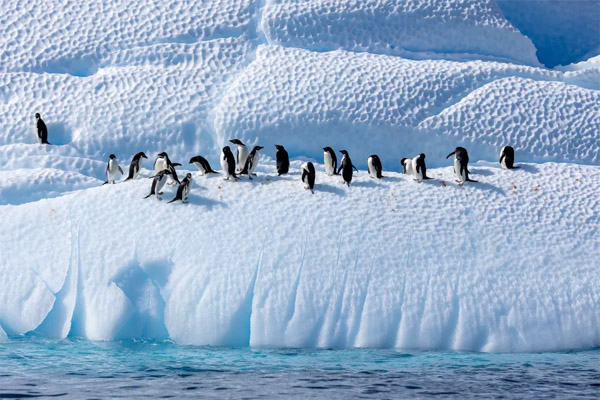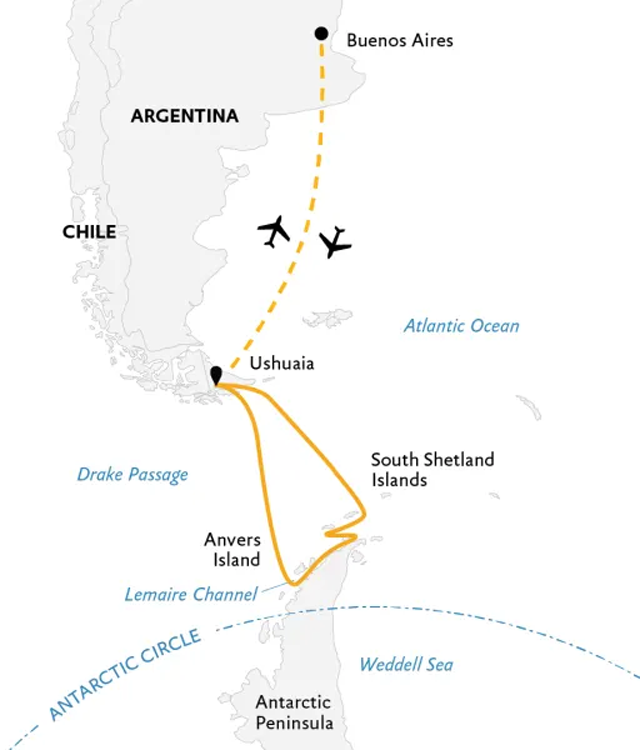HIGHLIGHTS
- Engage with globally-respected scientists who are actively
collecting data on Antarctic marine mammals, especially whales
- Participate in hands-on marine mammal identification
workshops
- Explore highlights of the Antarctic Peninsula
- Learn about Antarctic wildlife, history, geology and
glaciology from onboard polar experts
- In addition observing whales, witness penguins, seals and
birds
- Immerse yourself in the icy realm of the Antarctic with an
optional paddling excursion.
- In addition to daily presentations by polar experts, this
itinerary also features hands-on educational opportunities as part of
our new Science & Discovery program.
DATES / RATES
Rates are listed per person in USD. Promotional offers are not reflected in the rates below.
|
| Start Date | End Date | Infinity Suite | Veranda Suite | Superior Suite | Deluxe Suite | Owner's Suite |
|---|
| Mar 05, 2027 | Mar 15, 2027 | 14,195 | 14,895 | 19,395 | 20,895 | 22,295 |
| Mar 03, 2028 | Mar 13, 2028 | 14,095 | 14,895 | 19,295 | 20,795 | 22,295 |
Package Price: $1,295 USD
One-way Start: $795 USD
One-way End: $595 USD
Charter Flight and Hotel Package Includes:
- One night’s pre-expedition hotel accommodation in Buenos Aires with breakfast (Note: The number of guests per room is the same as cabin occupancy on the ship. Due to limited availability, travelers who reserve a suite on board are accommodated in standard rooms at the hotel. Triple rooms may not be available.)
- Group flight departing from Buenos Aires’ domestic airport (Aeroparque/AEP) to Ushuaia, and returning to Buenos Aires’ international airport (Ezeiza/EZE)
- Group transfer from hotel to airport in Buenos Aires
- Group transfer from Ushuaia airport to the ship, and return (Note: Transfer on arrival in Buenos Aires from airport to hotel at the beginning of the journey is not included. Please make your way to the included hotel.)
Rates are listed per person in USD. Promotional offers are not reflected in the rates below.
|
| Start Date | End Date | (Starting from)
Infinity Suite | (Mid-range)
Superior Suite | (High-end)
Owner's Suite |
|---|
| Mar 05, 2027 | Mar 15, 2027 | 14,195 | 19,395 | 22,295 |
| Mar 03, 2028 | Mar 13, 2028 | 14,095 | 19,295 | 22,295 |
Package Price: $1,295 USD
One-way Start: $795 USD
One-way End: $595 USD
Charter Flight and Hotel Package Includes:
- One night’s pre-expedition hotel accommodation in Buenos Aires with breakfast (Note: The number of guests per room is the same as cabin occupancy on the ship. Due to limited availability, travelers who reserve a suite on board are accommodated in standard rooms at the hotel. Triple rooms may not be available.)
- Group flight departing from Buenos Aires’ domestic airport (Aeroparque/AEP) to Ushuaia, and returning to Buenos Aires’ international airport (Ezeiza/EZE)
- Group transfer from hotel to airport in Buenos Aires
- Group transfer from Ushuaia airport to the ship, and return (Note: Transfer on arrival in Buenos Aires from airport to hotel at the beginning of the journey is not included. Please make your way to the included hotel.)
ITINERARY
Day
1: Arrive in Buenos Aires, Argentina
Upon
arriving in this fascinating South American city, known for its vibrant
Argentinian culture, European architecture and cosmopolitan vibe, you
will independently transfer to your pre- expedition hotel night,
included in the Charter Flight and Hotel Package.
Day
2: Fly to Ushuaia and Embark
After
an early breakfast at the hotel, the group will transfer to the airport
and board our private charter flight to Ushuaia, Argentina. Upon
arrival, you will be transferred from the airport to a central downtown
location to enjoy time on your own to explore this quaint port town
before making your way to the designated meeting spot near the pier,
where you will be transferred to the ship for embarkation. After a late
afternoon embarkation, we will sail along the historic Beagle Channel,
which transects the Tierra del Fuego archipelago in the extreme south
of South America. Expect an air of anticipation as you
depart—the next time you see land, you’ll be in the
remote Antarctic wilderness.
Day
3: At Sea: Drake Passage Southbound
Crossing
the 800-km Drake is considered a rite of passage for many travelers.
Traversing this legendary waterway means you’ll experience
the Antarctic Convergence, where the cold, northward- flowing Antarctic
waters meet the warmer, southward-flowing water of the sub-Antarctic.
The mixing of cold and warm waters creates a nutrient-rich feeding
ground, especially for whales and other marine mammals. Guests are
encouraged to keep binoculars close at hand—and to be
prepared for Expedition Team members to announce any whale sightings.
The team of guest scientists will be introduced early in the voyage.
Ari Friedlaender, who co-developed this itinerary, and members of his
team from the Friedlaender Lab, are global authorities on the
underwater behavior and ecology of marine mammals, particularly whales.
Guests will also meet a research associate with the Happywhale
platform, which enables citizens to upload their whale photos to help
identify species and, possibly, individual whales. (See bios, page 13).
Day
4: At Sea: Sailing Toward Antarctica
The
second day of your Drake Passage crossing is an ideal time to attend
scheduled polar presentations that will enhance your Antarctic
experience. It’s also an excellent opportunity to visit the
Science Hub on Deck 4 (see page 5), an instrumental part of your
voyage. Spend time on deck watching for whales, which increase in
number as we approach the Peninsula—and remember to upload
your whale photos to the Happywhale platform.
Day
5 to 7: Antarctic Peninsula
The
timing of this voyage maximizes opportunities to observe various whale
species along the Antarctic Peninsula. After the ice recedes in October
and November, the food chain begins to reestablish itself. Whales,
seals and other marine mammals are drawn to these rich feeding
grounds—especially for the krill. By February and March,
these creatures, which have been intensely feeding, are satiated and
relaxed, making them more easier to spot. In addition to the Zodiac and
paddling excursions, we plan to spend a lot of time on the outer decks
and other vantage points on the ship to spot—and
photograph—wildlife. We’ll spend our days in key
marine mammal habitats of the Gerlache Strait and remote inner glacial
bays. Over the next three days, we aim to explore whale hotspots such
as Charlotte Bay, Portal Point, Graham Passage, Errera Channel,
Cuverville Island, Andvord Bay, Fournier Bay and Dallmann Bay. Past
whale sightings in these areas have included minke, humpback, fin, orca
and the elusive, deep-diving Arnoux’s beaked whale. Antarctic
Marine Mammals: The World of Whales & Seals is our only
itinerary during which we’ll deploy hydrophones—
underwater microphones that detect and record sound below the surface.
You will have opportunities—during Zodiac cruises and
paddling programs—to accompany Friedlaender Lab scientists as
they deploy hydrophones to monitor and study marine mammal behavior,
such as the vocalizations of whales. Four scientists will accompany
guests in Zodiacs, with one hydrophone shared between two groups.
Speakers will enable participants to listen for and, hopefully, hear
whale sounds beneath the ocean surface. Engaging with scientists who
are actively collecting and collating data that can be shared in real
time on the water, and, through digital visual aids, brings marine
biology to life in a way that transcends the water line. This activity
is also available to World Voyager guests who join the Stand-Up Paddle
Boarding (SUP) program. In addition to the citizen science programming,
this itinerary will also feature the wonders of Antarctica: penguins,
seals, immense glaciers, snowcapped mountains, icebergs, shore
landings, and the polar plunge.
Day
8: South Shetlands
Rounding
out our marine mammal experiences, we hope to witness southern elephant
seals in the rugged and fabled South Shetland Islands. We’ll
also keep our fingers crossed for sightings of fin whales.
We’ll explore this geological and historic archipelago while
prioritizing shore landings, which offer further opportunities for
wildlife sightings. Arriving in March allows us the rare opportunity to
potentially explore key excursion sites such as Hannah Point, which is
deemed a Restricted Area from early to mid-season. Massive populations
of elephant seals and southern giant petrels make for awe-inspiring
experiences. As with any expedition, shore landings along the coast are
dependent on favorable weather.
Day
9: At Sea: Drake Passage Northbound
Today
is the start of the journey back across the Drake Passage. This is an
excellent opportunity to spend more time engaging with the Friedlaender
Lab scientists, or attend one of the scheduled polar presentations.
Day
10: At Sea: Last Sailing Day
Today
is your last opportunity to visit Quark Expeditions’ new
Science Hub and contribute to citizen science that will support marine
mammal conservation efforts. In the words of Sir David Attenborough:
“No one will protect what they don’t care about.
And no one will care about what they have never experienced.”
Day
11: Disembark in Ushuaia and Fly to Buenos Aires
You
will arrive in Ushuaia in the morning and disembark after breakfast.
Guests will be transferred to the airport for the return group charter
flight to Buenos Aires.
World Voyager QEX (Luxury Expedition, 198-guests)
Experience extraordinary Antarctica to the fullest and in the shortest amount of time aboard our newest yacht, World Voyager. Our NEW Drake Express option lets you fly straight into King George Island off the coast of Antarctica and over the Drake Passage both ways to maximize your boots on the ground exploration time. Or spend more time exploring the Antarctica Peninsula by flying over the Drake Passage one way and still lay claim to the iconic experience of sailing the other direction with our NEW Drake Fly & Sail options.
 (Click image to view Ship details)
(Click image to view Ship details)
WHAT'S INCLUDED
- Our team is comprised of the most professional and
passionate Expedition Leaders in the world, who bring a wide range of
experience and expertise to every adventure.
- Itineraries are packed with adventure options designed to
immerses travelers in the polar wilderness, enabling them to connect
with the natural wonders of their surroundings.
- Designed for comfort and adventure, each ship accommodates
no more than 200 guests. Facilities include comfortable cabins,
exceptional dining options, wellness treatments, and breathtaking
panoramic views of the polar landscape.
- Premium dining, with a wide selection of options that
accommodate a variety of dietary preferences.
- Complementary Wi-Fi, alcohol on all voyages, and the
Official Quark Expeditions parka to take home.
- Select voyages include essential transportation and
accommodation arrangements for guests, ensuring seamless travel to and
from the expedition starting point.
ADVENTURE OPTIONS - Kayaking: USD 1,995
- Paddling: USD 395
- Standup paddling: USD 295




